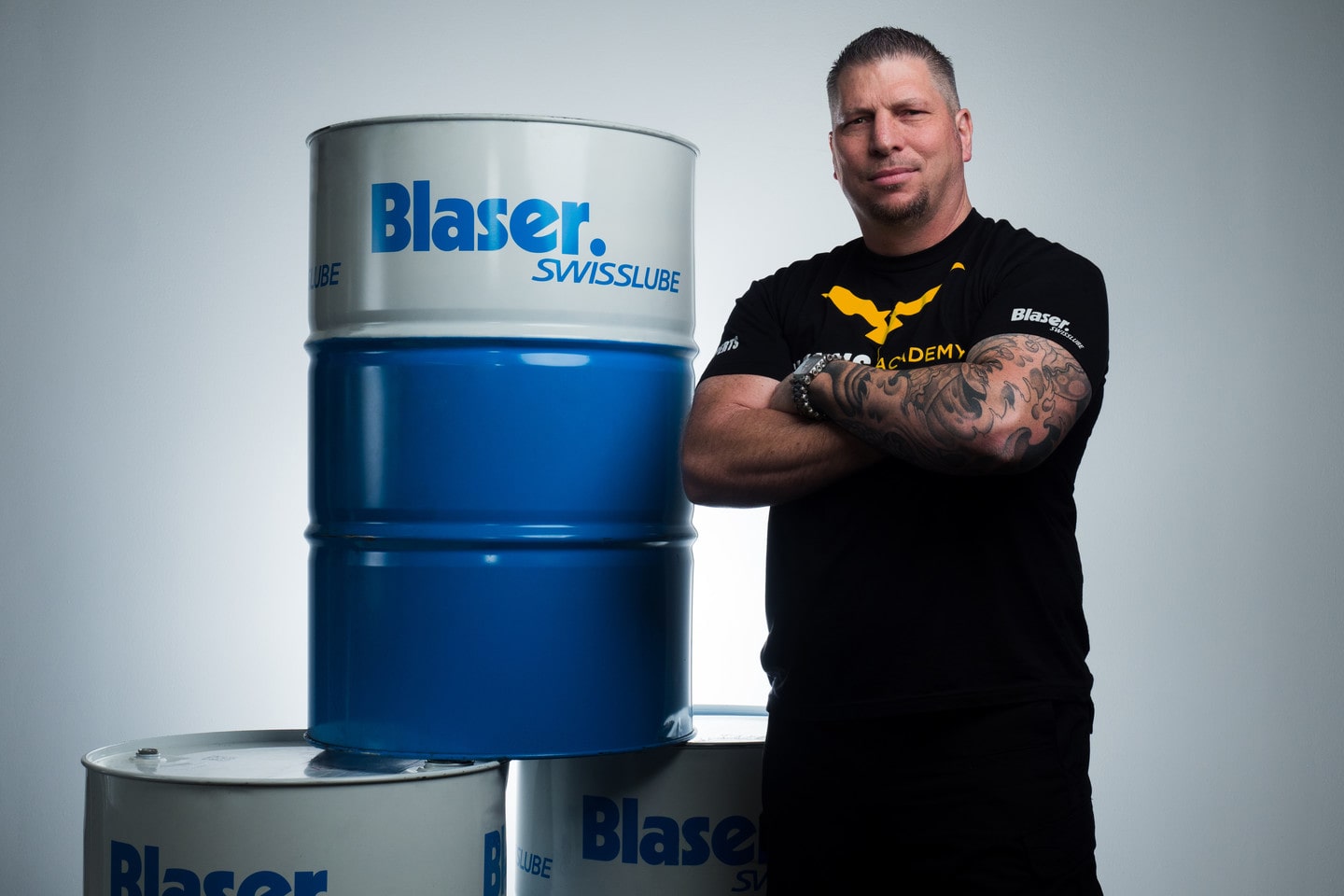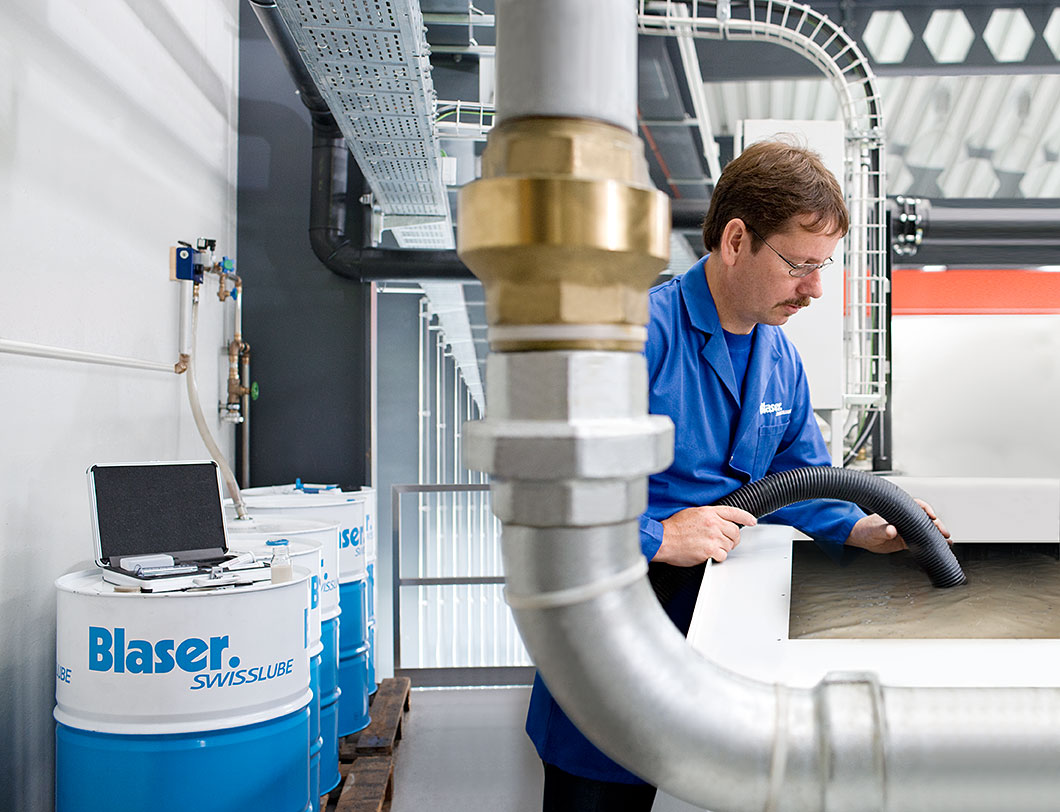
by Blaser Swisslube | May 29, 2021 | Education
An enthusiastic Blaser user – BOOM! Titan is a big Blaser fan Titan Gilroy is an enthusiastic Blaser user and owner of TITANS of CNC. He only uses the best metalworking fluids available on the market. Titan is a fighter, and with his online platform, TITANS of CNC Academy, he has given many people an understanding of machining technologies while sharing his knowledge. Titan Gilroy is the personification of the American Dream, having made it to the very top through his own hard work. A former boxer, he is now the owner of TITANS of CNC, a CNC manufacturing workshop in Northern California, US. He also produces and stars in the TV series by the same name, TITANS of CNC, (formerly: TITAN American Built). He has founded his online platform, TITANS of CNC Academy, to offer free training for those interested in machining, students and many more in the field of CAD, CAM and CNC. Titan designed the curriculum used by the trainers and students. The online portal is the first training platform of its kind and now has fans and visitors from all over the world. It all began with the CNC machining school in the San Quentin prison. The Titan knows first-hand that the American prison system could be doing a much better job. Many former inmates stated they found it difficult to resume their life in society and to find work. In order to offer the prisoners a new perspective and to train them, an entire workshop, including state-of-the-art equipment, was built based on his ideas. The concept was a complete success, as you can see in the video below. Collaboration with Blaser Swisslube Titan has made it his mission to promote training in the machining industry in the United States. Titans of CNC and Blaser Swisslube have been working together for almost two years now. In addition to sponsors like Autodesk, Haas and Kennametal, Blaser supports the Titans of CNC Academy’s free learning platform. Furthermore, Titan is one of our metalworking fluid test users – a symbiotic collaboration. In January 2016, the time had come for Titan and his crew to pay us a visit. See the film about Titans’ 2022 visit at Blaser Swisslube, Switzerland here. Titans of CNC Academy – The Free Training Platform You can find a number of different learning modules in the fields of programming, tool optimization and metalworking fluid handling on the Academy website. The purpose of the platform is to enable interested parties to develop and learn new things. His followers include both...

by Blaser Swisslube | May 28, 2021 | Education
What happens with the metalworking fluid samples? The journey of the metalworking fluid samples through the laboratory Triage for customer samples Our customers from all over the world send metalworking fluid samples to Hasle Rüegsau in Switzerland. Hundreds of customer samples found their way to our laboratory last year, where they were analyzed in detail by our specialists. Almost 7,000 of these samples were sent to the microbiologists in our customer service team. What happens with a customer sample? What is involved in standard analysis and what is the difference between a dip slide and a plater? Triage for customer metalworking fluid analysis In the early morning, all the metalworking fluid samples that have arrived from customers all over the world are lined up on the laboratory bench in customer service. Each sample is delivered together with a sampling report. This records the customer name, products used, tank size, filling date and much more. Measurements showing the concentration and the local pH value are also included. Each of these customer samples is now assigned a unique internal number and all the data collected are recorded electronically. The samples that have arrived for standard analysis include the following two used emulsions, which I will now deal with in a little more detail: Customer sample 1 Customer sample no. 1 / Customer sample from Germany A German customer uses our B-Cool metalworking fluid. The pH value and the concentration have already been measured on site and our sales representative sent a sample from the 6,000 liter sump to Switzerland for further analysis. Customer sample no. 2 / Customer sample from Switzerland A Swiss customer has been using a Blasocut metalworking fluid for several years. In order to check the condition of the emulsion, a sample of the used emulsion was taken from the customer’s central system. Because of their different product properties, the two customer samples now complete different test procedures. Customer sample 2 CustomerYeast, mold and bacteria cultivated on nutrient agar Customer sample no. 1 – Analysis of conserved products: Microbial growth is not usually tolerated in traditional products because the ingredients suppress the growth of microorganisms in the ready-to-use product. In order to check that everything is in order with the metalworking fluid, we use the so-called dip slide for analysis. The dip slide is coated on both sides with a nutrient agar. If bacteria, yeast and/or...

by Blaser Swisslube | May 28, 2021 | Education
Ramping up production? How to restart CNC machines the proper way. If your shop is ready to restart production, check that the metalworking fluid has been properly maintained and is in good condition before powering up the machine. Water-miscible metalworking fluids cannot be left on their own. Without monitoring and maintenance there is a risk of developing unpleasant odors, corrosion in the machine or residue on finished parts. If you had an extended shutdown and machines were left with water-miscible fluids in the sump, follow this guide to ensure the coolant is in good and stable condition before re-use. Re-start checklist for water-miscible coolants Download the Checklist PDF and step-by-step guidance on how to restart machines the proper way, including: Tips for visual inspection Steps to check and adjust concentration How to achieve the proper pH Recommended maintenance This download may also interest you: Water-miscible coolant care – 7 tips for success PDF Restart with cutting and grinding oils The proper steps for restarting a CNC machine take into consideration the sump tank size, coolant age, coolant condition, and disposal costs of the metalworking fluid. Your local Blaser Area Manager or Blaser Customer Service Representative is ready to assist you in evaluating any concerns. We are here for you Although cutting and grinding oils do not need specific precautions, a production stop may be a good opportunity to clean the machines and change to a new oil – something you may have wanted to do for a while but never got around to it. With neat oils, proper cleaning of your machines is crucial to avoid any contamination of the new oil. Watch the video for step-by-step instructions. In the download section below, you can also find a PDF with all steps explained in detail. Just fill in the contact form below for immediate assistance. Please enable JavaScript in your browser to complete this form.Title *Mrs/MsMrName *FirstLastCompany *Zip / Postal Code *PhoneEmail *MessageCheckboxes *By submitting this form you agree to our Data Protection PolicySubmit Downloads Water-miscible coolant checklist for re-starting after shutdown Download PDF Blaser College: Maintenance of water-miscible metalworking fluids during production stops Download PDF Blaser College: Neat oils – cleaning and filling of machines Download PDF Water-miscible coolant care – 7 tips for success Download PDF Blaser College: water-miscible coolants – cleaning and filling of machines...




Recent Comments